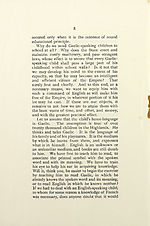Download files
Complete book:
Individual page:
Thumbnail gallery: Grid view | List view

9
be better to begin by teaching him to read in
English, so that he might first be got to under*
stand what reading means? When he had
mastered the elements of the art, and could
draw instruction from the book as well as from
the voice, we could then teach him French
through English; and have two gateways of
knowledge open instead of one. In this way it
seems to me we should fulfil two elementary
conditions commended both by psychology and
commonsense; which are at the basis of all sound
education, namely that in teaching a child we
should (i) proceed from the known to the
unknown, and (2) take one step at a time. To
read at all is one step, to read a foreign language
is another step. The home-language is the known,
the foreign language is the unknown. What is
true and sound when French is the foreign
language for the English speaking child does not
become untrue and unsound when it is a case of
the Gaelic-speaking child learning English.
The Bi-lingual Faculty.
I am almost ashamed to insist on principles so
rudimentary, and so generally admitted—outside
certain School Board districts in the Highlands.
Yet I understand that there the practical deduc¬
tion which inevitably follows is neither conceded
nor acted upon. It is not realised, even by
those who are most anxious to save the rates and
to earn grants* that it is quicker and cheaper to
teach the Gaelic-speaking child to read Gaelic
first, and through Gaelic to read and speak
English, than to put into his hand an English
book for his first reading lesson, and expect him
to master the difficulties both of reading and of
English at the same time. Putting aside the
question of the loss of time and money involved
be better to begin by teaching him to read in
English, so that he might first be got to under*
stand what reading means? When he had
mastered the elements of the art, and could
draw instruction from the book as well as from
the voice, we could then teach him French
through English; and have two gateways of
knowledge open instead of one. In this way it
seems to me we should fulfil two elementary
conditions commended both by psychology and
commonsense; which are at the basis of all sound
education, namely that in teaching a child we
should (i) proceed from the known to the
unknown, and (2) take one step at a time. To
read at all is one step, to read a foreign language
is another step. The home-language is the known,
the foreign language is the unknown. What is
true and sound when French is the foreign
language for the English speaking child does not
become untrue and unsound when it is a case of
the Gaelic-speaking child learning English.
The Bi-lingual Faculty.
I am almost ashamed to insist on principles so
rudimentary, and so generally admitted—outside
certain School Board districts in the Highlands.
Yet I understand that there the practical deduc¬
tion which inevitably follows is neither conceded
nor acted upon. It is not realised, even by
those who are most anxious to save the rates and
to earn grants* that it is quicker and cheaper to
teach the Gaelic-speaking child to read Gaelic
first, and through Gaelic to read and speak
English, than to put into his hand an English
book for his first reading lesson, and expect him
to master the difficulties both of reading and of
English at the same time. Putting aside the
question of the loss of time and money involved
Set display mode to:
![]() Universal Viewer |
Universal Viewer | ![]() Mirador |
Large image | Transcription
Mirador |
Large image | Transcription
| An Comunn Gàidhealach > An Comunn Gàidhealach Publications > Gaelic in the Highland schools > (9) |
|---|
| Permanent URL | https://digital.nls.uk/122769679 |
|---|
| Description | This contains items published by An Comunn, which are not specifically Mòd-related. It includes journals, annual reports and corporate documents, policy statements, educational resources and published plays and literature. It is arranged alphabetically by title. |
|---|
| Description | A collection of over 400 items published by An Comunn Gàidhealach, the organisation which promotes Gaelic language and culture and organises the Royal National Mòd. Dating from 1891 up to the present day, the collection includes journals and newspapers, annual reports, educational materials, national Mòd programmes, published Mòd literature and music. |
|---|---|
| Additional NLS resources: |
|

